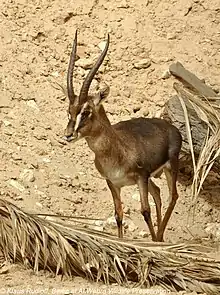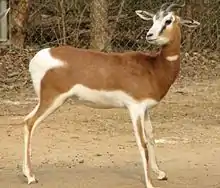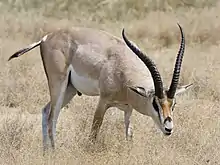Gazelle
A gazelle is any of many antelope species in the genus Gazella. This article also deals with the six species included in two further genera, Eudorcas and Nanger, which were formerly considered subgenera of Gazella. A third former subgenus, Procapra, includes three living species of Asian gazelles.
| Gazelle Temporal range: Pliocene to recent | |
|---|---|
.jpg.webp) | |
| Rhim gazelle | |
| Scientific classification | |
| Kingdom: | Animalia |
| Phylum: | Chordata |
| Class: | Mammalia |
| Order: | Artiodactyla |
| Family: | Bovidae |
| Subfamily: | Antilopinae |
| Tribe: | Antilopini |
| Genus: | Gazella Blainville, 1816 |
| Species | |
|
Several, see text | |
Gazelles are known as swift animals. Some are able to run at bursts as high as 100 km/h (60 mph) or run at a sustained speed of 50 km/h (30 mph).[1] Gazelles are found mostly in the deserts, grasslands, and savannas of Africa; but they are also found in southwest and central Asia and the Indian subcontinent. They tend to live in herds, and eat less coarse, easily digestible plants and leaves.
Gazelles are relatively small antelopes, most standing 60–110 cm (2–3.5 ft) high at the shoulder, and are generally fawn-colored.
The gazelle genera are Gazella, Eudorcas, and Nanger. The taxonomy of these genera is confused, and the classification of species and subspecies has been an unsettled issue. Currently, the genus Gazella is widely considered to contain about 10 species.[2] Four further species are extinct: the red gazelle, the Arabian gazelle, the Queen of Sheba's gazelle, and the Saudi gazelle. Most surviving gazelle species are considered threatened to varying degrees. Closely related to the true gazelles are the Tibetan and Mongolian gazelles (species of the genus Procapra), the blackbuck of Asia, and the African springbok.
One widely familiar gazelle is the African species Thomson's gazelle (Eudorcas thomsoni), which is around 60 to 70 cm (24 to 28 in) in height at the shoulder and is coloured brown and white with a distinguishing black stripe. The males have long, often curved, horns. Like many other prey species, Tommies and springboks (as they are familiarly called) exhibit a distinctive behaviour of stotting (running and jumping high before fleeing) when they are threatened by predators, such as cheetahs, lions, African wild dogs, crocodiles, hyenas, and leopards.
Etymology and name
Gazelle is derived from Arabic: غزال ġazāl,[3] Maghrebi pronunciation ġazēl.[4] To Europe it first came to Old Spanish and Old French,[4] and then around 1600 the word entered the English language.[5] The Arab people traditionally hunted the gazelle. Appreciated for its grace, it is a symbol most commonly associated in Arabic literature with female beauty.[6] In many countries in Northwestern Sub-Saharan Africa, the gazelle is commonly referred to as "dangelo", meaning "swift deer".[7]
Symbolism or totemism in African families
The gazelle, like the antelope to which it is a family of, is the totem of many African families such as the Joof family of the Senegambia region,[8][9] the Bagananoa of Botswana in Southern Africa - said to be descended of the BaHurutshe,[10] and the Eraraka (or Erarak) clan of Uganda.[11] As common in many African societies, it is forbidden for the Joof or Eraraka to kill or touch the family totem.[9][11]
Poetry
One of the traditional themes of Arabic love poetry involves comparing the gazelle with the beloved, and linguists theorize ghazal, the word for love poetry in Arabic, is related to the word for gazelle.[12] It is related that the Caliph Abd al-Malik (646–705) freed a gazelle that he had captured because of her resemblance to his beloved:
O likeness of Layla, never fear!
For I am your friend, today, O wild gazelle!
Then I say, after freeing her from her fetters:
You are free for the sake of Layla, for ever![12]
The theme is found in the ancient Hebrew Song of Songs. (8:14)
Come away, my beloved,
and be like a gazelle
or like a young stag
on the spice-laden mountains.
Species
The gazelles are divided into three genera and numerous species.[13]
† = extinct
Prehistoric extinctions
Fossils of genus Gazella are found in Pliocene and Pleistocene deposits of Eurasia and Africa. The tiny Gazella borbonica is one of the earliest European gazelles, characterized by its small size and short legs. Gazelles disappeared from Europe at the start of the Ice Age, but they survived in Africa and Middle East.
- Genus Gazella
- Gazella borbonica - European gazelle
- Gazella thomasi - Thomas's gazelle
- Gazella harmonae - Pliocene of Ethiopia, unusual spiral horns[16]
- Gazella praethomsoni
- Gazella triquetrucornis
- Gazella negevensis
- Gazella capricornis
- Subgenus Vetagazella
- Gazella sinensis
- Gazella deperdita
- Gazella pilgrimi - steppe gazelle
- Gazella leile - Leile's gazelle
- Gazella praegaudryi
- Gazella gaudryi
- Gazella paotehensis
- Gazella dorcadoides
- Gazella altidens
- Gazella mongolica - this is not the Procapra gutturosa
- Gazella lydekkeri - Ice Age gazelle
- Gazella blacki
- Gazella parasinensis
- Gazella kueitensis
- Gazella paragutturosa
- Subgenus Gazella
- Gazella janenschi
- Subgenus Trachelocele
- Gazella atlantica
- Gazella tingitana
- Subgenus Deprezia
- Genus Nanger
- Nanger vanhoepeni
Gallery
 Grant's gazelle (male)
Grant's gazelle (male)
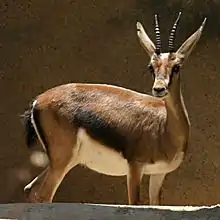 Cuvier's gazelle (female)
Cuvier's gazelle (female) Thomson's gazelle (male)
Thomson's gazelle (male).jpg.webp) Speke's gazelle (female)
Speke's gazelle (female) Goitered gazelle (females and young)
Goitered gazelle (females and young) Chinkara (female)
Chinkara (female) Dorcas gazelle (female)
Dorcas gazelle (female)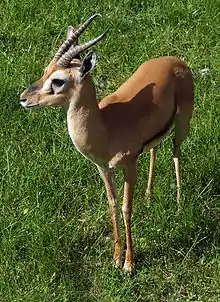
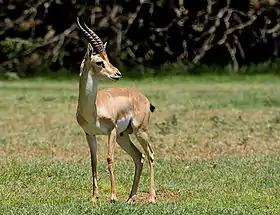 Mountain gazelle (male)
Mountain gazelle (male)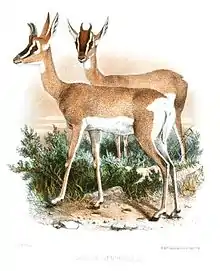 Soemmerring's gazelle (females)
Soemmerring's gazelle (females).jpg.webp) Slender-horned gazelle (male)
Slender-horned gazelle (male)
References
- "Gazelle". The Columbia Electronic Encyclopedia, 6th ed. 2007, Columbia University Press.
- Eva Verena Bärmann; et al. (2013), "The curious case of Gazella arabica", Mammalian Biology - Zeitschrift für Säugetierkunde, 78 (3): 220–225, doi:10.1016/j.mambio.2012.07.003
- Skeat, Walter W. (1910). "gazelle". An Etymological Dictionary of the English Language (4th ed.). Oxford: Clarendon Press. p. 236.
- "gazelle". CNRTL.
- Merriam-Webster - Gazelle, Accessed: 22 December 2009
- Behrens-billAbouseif, Doris (1999). Beauty in Arabic culture (Illustrated ed.). Markus Wiener Publishers. p. 53. ISBN 9781558761995.
- https://www.youtube.com/watch?v=roJ97b4t-dE&feature=youtu.be
- Faye, Louis Diène, Mort et naissance: le monde Sereer, Nouvelles Éditions africaines (1983), p. 74, ISBN 9782723608688
- Gastellu, Jean-Marc (M. Sambe - 1937), L'égalitarisme économique des Serer du Sénégal, IRD Editions (1981), p. 130, ISBN 9782709905916
- Chidester, David; Kwenda, Chirevo; Petty, Robert; Tobler, Judy; and Wratten, Darrel ; African Traditional Religion in South Africa: An Annotated Bibliography: An Annotated Bibliography, ABC-CLIO (1997), p. 341, ISBN 9780313032257
- Roscoe, John, The Northern Bantu: An Account of Some Central African Tribes of the Uganda Protectorate, The University Press (1915), p. 262
- Necipoğlu, Gülru (1997). Gülru Necipoğlu (ed.). Muqarnas: An Annual on the Visual Culture of the Islamic World (Illustrated ed.). BRILL. ISBN 9789004108721.
- "Antilopinae". Retrieved 1 July 2008.
- Participants at 4th International Conservation Workshop for the Threatened Fauna of Arabi 2003. Gazella saudiya. In: IUCN 2006. 2006 IUCN Red List of Threatened Species. <www.iucnredlist.org>. Downloaded on 7 October 2006.
- IUCN SSC Antelope Specialist Group 2008. Gazella saudiya. In: IUCN 2008. 2008 IUCN Red List of Threatened Species. <www.iucnredlist.org>. Downloaded on 18 December 2008.
- Geraads, D.; et al. (2012). "Pliocene Bovidae (Mammalia) from the Hadar Formation of Hadar and Ledi-Geraru, Lower Awash, Ethiopia". Journal of Vertebrate Paleontology. 32 (1): 180–197. doi:10.1080/02724634.2012.632046. S2CID 86230742.
External links
| Wikimedia Commons has media related to Gazella. |
 Quotations related to Gazelles at Wikiquote
Quotations related to Gazelles at Wikiquote




.jpg.webp)

